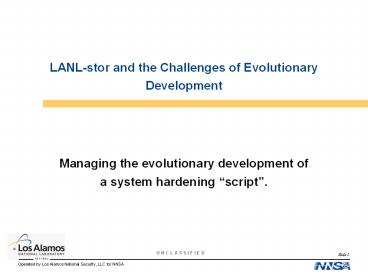LANL-stor and the Challenges of Evolutionary Development - PowerPoint PPT Presentation
1 / 20
Title:
LANL-stor and the Challenges of Evolutionary Development
Description:
Lack of advanced data-types and language features limited development process. ... planning = faster development. Talk to your customers. Don't skimp on testing. ... – PowerPoint PPT presentation
Number of Views:33
Avg rating:3.0/5.0
Title: LANL-stor and the Challenges of Evolutionary Development
1
LANL-stor and the Challenges of Evolutionary
Development
- Managing the evolutionary development of a system
hardening script.
2
Overview
- What is LANL-stor.
- Themes in the evolution of LANL-stor.
- Origins.
- Mid-life crisis.
- Current status.
- Future directions.
- Lessons learned
3
RHEL Security Triangle
- Red Hat Network Satellite Server (RHUS).
- Patch management capabilities.
- LANL ExpressWay Red Hat.
- Network based installation tool.
- LANL Security Tool On Red-Hat (STOR).
- Secure configuration.
- Configuration compliance reporting
4
STOR
- Current version is 4.0.
- System hardening tool for Red Hat Enterprise
Linux. - Based on
- The Center for Internet Security (RHEL 4 5
Benchmarks). - The NSA Guide to the Secure Configuration of RHEL
5. - The DISA UNIX STIG and Checklist.
- NIST.
- MITRE CCE List for RHEL 5.
- Internal requirements.
5
STOR - Development
- Source documents are reviewed for applicability,
automation potential, correctness and deployment
impact. - Field team feedback from previous versions is
considered. - Informal requirements outline generated
(developer use only). - New actions are unit tested then integrated into
the main program(s). - The main program is tested on virtual machines
representing all supported versions ( currently 3
- 5). - CSD Standards and RD Team members test during an
internal alpha test period.
6
STOR Development cont.
- Internal review meeting held prior to CCB.
- Change Control Board reviews changes in guidance
and program functionality. Makes recommendations. - CCB changes are integrated into program.
- Internal beta test period.
- Public beta test period.
- Production.
7
Themes
- Evolution in source material (CIS, NIST, NSA,
DISA). - Evolution in internal requirements.
- Continuous change in program architecture.
- Growing complexity
- Variances between RHEL versions.
- Additional features.
- Special cases.
8
STOR Origins
- Early years (versions 0.1 - 1.12).
- Simple run once bash script.
- No customization without altering the script.
- Intolerant of use on anything but a fresh
install. - lt 2000 lines.
- Mostly cut and paste from early CIS Benchmark
scripts. - Very incomplete implementation of CIS Benchmark.
9
STOR Origins
- Growing up (versions 2.x-3.0).
- More focus on being able to run repeatedly
without breakage. - More flexible about preserving local
configurations. - Tuneable via a configuration file.
- Improved coverage of CIS Benchmark.
- With config file added optional hardening
actions. - Undo function.
- gt 6,500 lines by 3.0.
10
STOR Origins
- Mid Life Crisis (v. 3.1).
- Audit and reporting functions.
- Support for RHEL 3 - 5.
- Optional GUI.
- gt 9,300 lines.
11
STOR Origins
- Optional GUI (ver. 3.1).
12
STOR Origins
- Mid-Life Crisis (v. 3.1) Issues.
- Huge code base of shell code difficult to manage.
- Lack of advanced data-types and language features
limited development process. - Performance Required run time with all features
turned on had become very long. - Limited ability to integrate main code with GUI.
- Limited ability to handle errors in a predictable
way.
13
STOR Current
- Welcome to 4.0!
- Completely re-written in Python.
- More new hardening features.
- All new GUI.
- Can now execute single rules for easier debugging
and targeted fixes. - Initial port cut STOR line count from 9K to
7K. - Current line count 13,600 (9892 core, 3699 GUI).
14
STOR Current
- Why Python?
- Previous STOR GUI was written in Py-QT.
- Flexible.
- Readable.
- Faster than shell.
- Speed of development.
- Batteries included.
- Easier integration with the GUI layer.
- Natively object oriented without forcing object
oriented development. - Good native exception handling capabilities.
- Native to Red Hat yet available cross-platform
15
STOR Origins
- New GUI
16
STOR Origins
- GUI Configuration Tool
17
STOR Origins
- Online Help
18
STOR Future Plans
- Tighter integration with the GUI without breaking
command line function. - Extend to cover additional Operating Systems.
- Solaris
- Ubuntu
- Mac?
- Move to full object oriented development.
- Develop automated testing harness
19
Lessons Learned
- Don't fear the re-write!
- Take chances, fortune favors those who are in the
right place at the right time. - Challenge assumptions.
- Document your code the sanity you save may be
your own. - Upfront planning faster development.
- Talk to your customers.
- Don't skimp on testing.
20
LANL-stor and the Challenges of Evolutionary
Development
- Questions?
- LANL-stor author
- David Kennel
- Departmental Computing Services
- Central Services and Development Team
- dkennel_at_lanl.gov































